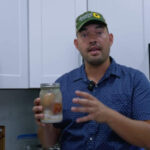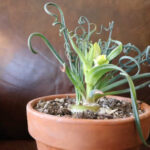Growing swiss chard is a delicious and healthy way to cultivate a member of the Amaranthaceae family. It is known as s nutritional powerhouse and is loaded with nutrients and vitamins, especially A, C, K, and the vitamin B group. Even better, this leafy vegetable has an extremely low-calorie count. One cup of chopped Swiss chard contains only 35 calories. Growing Swiss chard can be a great thing for your health!
The word “chard” descends from the French word cadre, meaning artichoke thistle. Unfortunately, the origin of the word “Swiss” is less clear, especially as the vegetable is not native to Switzerland. Regardless, it is used extensively in traditional Swiss cuisine. It was first described by a Swiss botanist, which may have something to do with the term “Swiss” in its name.
Swiss chard is a leafy green vegetable closely related to beets. However, while beets are grown for the roots, chard is generally cultivated for its leaves, which incidentally taste much like beet greens. With swiss chard, how to grow it successfully is relatively easy, and the health benefits of this tasty vegetable are well worth the effort.
Quick Care Guide
 Growing swiss chard is relatively simple and very rewarding. Source: dnfisher
Growing swiss chard is relatively simple and very rewarding. Source: dnfisher| Common Name(s) | Silverbeet, perpetual spinach, seakale beet, leaf beet, and beet spinach |
| Scientific Name | Beta vulgaris subsp. vulgaris |
| Days to Harvest | 55 to 60 |
| Light | Partial to full sun |
| Water | Moderate, about 1″ to 1.5″ weekly |
| Soil | Loamy, well-drained |
| Fertilizer | Nitrogen-rich slow-release fertilizer |
| Pests | Aphids, darkling beetles, flea beetles, beet leafhopper |
| Diseases | Beet curly top virus, fungal root rot, damping off |
All About Chard
 A closeup of swiss chard leaves. Source: Jeff Moser
A closeup of swiss chard leaves. Source: Jeff MoserSwiss chard was first named Beta vulgaris by a Swedish botanist, Carl Linnaeus. Over the years, it became viewed as a subspecies. Nowadays, it goes by the botanical name of Beta vulgaris subsp. vulgaris. It is also known by a number of common names, although silverbeet, chard, Swiss chard, or leaf beet are likely the best-known.
These plants average 18 inches tall to 24 inches tall. They have big, dark green leaves with pronounced ribbing. The stalk can be white, yellow, or red, depending on the cultivar. Sometimes, the stalk features a mix of colors. During the second year of growth, the plant also produces small green flowers on top of the flowering stalks.
With big dark green leaves, the foliage is beautiful and makes these plants an excellent garden crop, or an addition to a flower garden. It propagates through seeds that are typically sown between April and August in the Northern hemisphere. The plant takes around 50 to 60 days to mature.
Chard (swiss or otherwise) is believed to have originated from a wild version of beet, native to the Mediterranean. The original variety has been traced back to Sicily. It has been naturalized in Europe and the Americas. However, this veggie is rarely consumed outside Europe.
If you want to grow Swiss chard, popular varieties include Bright Lights, Fordhook Giant, Ruby Chard, or Lucllus. I’ve been growing Bright Lights swiss chard for years and it’s always a delight to see. Growing rainbow chard can really liven up the garden with tons of bright color!
Planting Swiss Chard
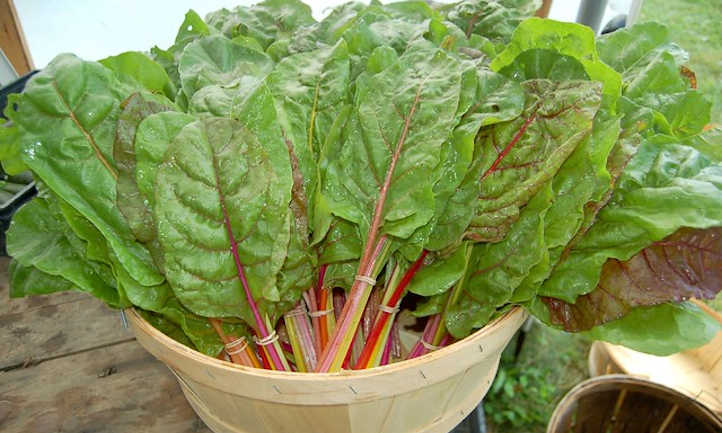 Chard stems can be a rainbow of colors. Source: Leeks ‘N’ Bounds
Chard stems can be a rainbow of colors. Source: Leeks ‘N’ BoundsWhether you plan on harvesting the leaves, or want to grow it for its beautiful garden aesthetic, we have lots of tips on how to grow Swiss chard like a pro!
If when to plant swiss chard is your question, it is typically grown as a cool-season crop. It thrives in cooler temperatures in fall and spring. Swiss chard growth often slows down as the temperature rises.
The best time to plant Swiss chard seeds is 2 to 3 weeks before the last spring frost date. For a fall crop, plant seeds about 40-50 days before the first fall frost date. Sow seeds no deeper than ½” to ensure good germination. The optimal germination temperature for Swiss chard is 85 Fahrenheit, but the plant itself performs best between 40 F to 95 F.
For transplants, get them established when the weather is still warm for good growth. Space your chard 12 inches to 18 inches apart, although you may be able to put them as close as 10 inches apart in a well-fertilized raised bed. The leaves may appear limp shortly after transplant, but will bounce right back!
Growing chard from seed is easy. A short pre-soak can speed seed germination. Then, sow the seeds ½ inch deep at least 2 inches apart in a row. Thin to 12 inches apart once they have their first true leaves. Rows should be spaced 18 to 24 inches apart. For square foot gardeners, aim for 4 plants per square foot.
Caring for Swiss Chard
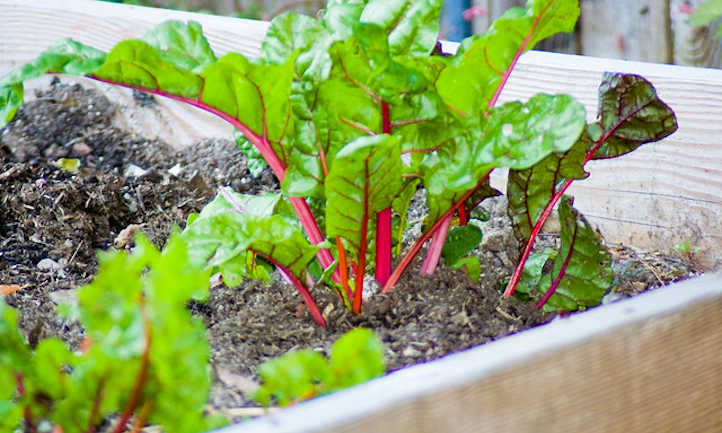 Swiss chard grows very well in raised beds. Source: swifthandsam
Swiss chard grows very well in raised beds. Source: swifthandsamSwiss chard is easy to grow, but your Swiss chard plant still requires proper care to truly thrive. Let’s examine the finer points of how to grow chard in your garden.
Sun and Temperature
Swiss chards enjoy sunlight and do well in full to partial sun. Ideally, these plants should get around 6 to 8 hours of sunlight every day. They are slightly frost hardy but don’t do well with long periods of sub-freezing temperatures.
The ideal temperature range to grow swiss is 32 F to 75 F. If you have very cold winters, it is best to use a cold frame to keep your plants warm, or alternately you can move your plants inside. The USDA growing zone is 2-11.
Watering and Humidity
Like most vegetables, Swiss chard requires a steady and even supply of water, about 1 to 1.5 inches of water every week. The goal is to keep the soil evenly moist.
Insufficient water slows down growth of leaves and stems. You may have to water your Swiss chard plants more in hot temperatures than during cooler months of the year. Mulch the plants at the base to conserve soil moisture. A soaker hose works great for irrigation.
Soil
Chard plants grow best in rich and organic loamy soil. They’re able to tolerate some poor soils, but won’t be as vigorous. Add compost to your soil before planting, particularly if it’s clay-dense. Sandier soils allow for good drainage but could use some compost to retain moisture as well. Aim for a pH level between 6.0 and 6.8.
Fertilizing
As you’re probably going to grow Swiss chard for the leaves and stalk rather than its root, you’ll want to ensure you fertilize your plants so they can grow well. A nitrogen-rich, slow-release fertilizer is ideal for leaf production as it will supply plenty of nutrition for the development of big, healthy Swiss chard leaves.
Pruning
The only time you should need to prune your Swiss chard is if it tries to bolt to seed. At that time, leave only a few stalks and cut the rest of the plant back to 1 inch above soil level. The remaining green leaves help the plant to photosynthesize as it refocuses its energy on growing new leaves. This does not always prevent bolting, but it can slow it down to extend the plant’s lifespan.
Otherwise, most pruning is performed as part of harvesting or to remove damaged leaves. Outer leaves and stalks are usually harvested first, leaving the inner stalks to act as photosynthesizers.
Propagation
Swiss chard propagates through seeds, and all other methods are unlikely to work. You can start the seeds indoors or sow them directly into beds. Choose good quality seeds from a reliable source.
The seedlings will appear in 1 to 2 weeks and can be placed outside after the last frost date has passed. It is advisable to acclimate the seedlings outdoors for a couple of hours every day before transplanting them outside in the ground or container.
Harvesting and Storing
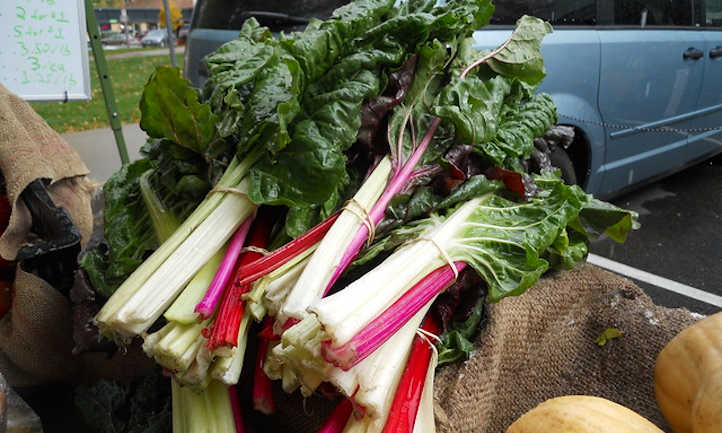 Once harvested, chard can be eaten fresh or blanched and frozen. Source: mtnlover61
Once harvested, chard can be eaten fresh or blanched and frozen. Source: mtnlover61Now that you know how to grow Swiss chard, let’s see how to harvest and store it. The best part about Swiss chard is that you can cut and come again, getting multiple harvests over the growing season. So if you’re wondering how to harvest swiss chard, let’s discuss that!
Harvesting Swiss Chard
You can harvest the dark green leaves and stalks of Swiss chard. It grows back quickly, so you can harvest many times throughout the growing season.
Whether you are harvesting young or mature leaves, make sure you take the outer leaves first. Leave the inner leaves and let them grow. You can use a pair of sterile pruning snips to make clean cuts about one inch above soil level.
Storing
For short-term storage, place the cut end of stems in a small amount of water. Put a plastic bag over the top of the leaves. This will allow the stems to retain their moisture, although the leaves will start to wilt within 24 hours. This method is best if you harvest in the morning and plan to cook the stalks for dinner that evening.
For a slightly longer storage time, wrap your Swiss chard stalks and leaves in paper towels and place them in a plastic bag, pressing as much of the air out as possible. Store in the crisper drawer. You should get 3-4 days of storage using this method.
Don’t wash your harvest until just before you use it. Prolonged exposure to moisture can cause the leaves to decay quickly and the stalks to turn mushy.
Store your swiss chard for long-term use by freezing. Wash and dry your chard, then remove the swiss chard leaves from the stems. Blanch the dark green leaves in boiling water for one minute, then remove them to an ice bath to stop cooking. Stems should be blanched for two minutes, then put in an ice bath. This helps the green leaves retain their color.
Once your produce is blanched, thoroughly dry it out and put it on a parchment-lined baking sheet. Freeze until solid, then transfer to a freezer storage bag for later use.
Troubleshooting
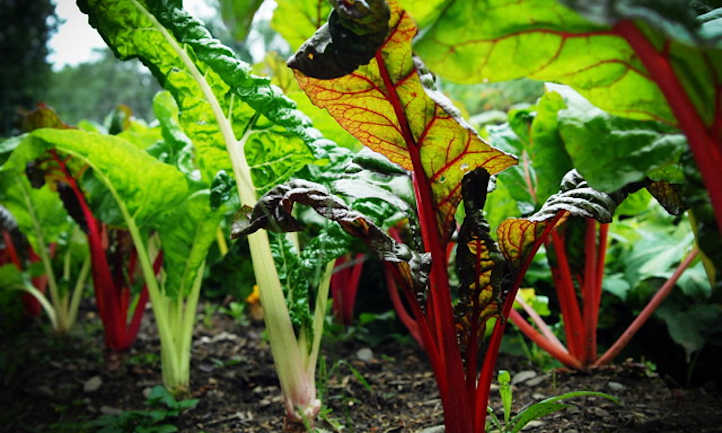 Light radiating through young chard leaves. Source: M J M
Light radiating through young chard leaves. Source: M J MThere are some common problems associated with growing Swiss chard that you should be aware of. When it comes to diseases, Swiss chard has a few. Let’s discuss those in detail.
Growing Problems
These plants are slightly frost-hardy but may not survive very cold winters. Provide a cold frame or grow in containers you can bring indoors if the weather gets cold.
Swiss Chard Pests
Aphids are tiny sap-sucking insects that often infest vegetable plants. You can get rid of them by spraying the plant with neem oil, horticultural oils, or insecticidal soap. Environmental controls include ladybugs and lacewings.
The darkling beetle is useful if you’re raising mealworms to feed chickens with, but it’s bad to have in the garden. Both adults and their mealworm larvae will cannibalize the leaves of plants. Unfortunately, insecticides aren’t very effective against them, although pyrethrin may reduce their numbers slightly. Keep the area around your plants clean of debris and hand-pick adult beetles when you find them.
Flea beetles eat a shot-hole pattern through leaves, disfiguring them and reducing the amount of harvest. These respond well to spinosad or pyrethrin control measures.
Finally, while they do cause some vegetative damage to leaves, the beet leafhopper is a dangerous vector for plant diseases. These can be difficult to eliminate, but using an insecticidal soap and pyrethrin blend is usually effective for killing off larvae.
Diseases
Beet curly top virus is a viral infection that is characterized by small, yellow, and curling leaves with swollen veins. Spread by beet leafhoppers to chard, there are no treatments for this disease, so it’s essential to prevent it.
Poor draining soil can lead to fungal root rot in your plants. Use well-draining soil and avoid overwatering. When growing in pots, make sure your pot has big drainage holes to ensure good drainage and no water retention.
Damping-off can be caused by a number of soilborne fungi. Some products like MycoStop can aid in the control of a few of these, like fusarium. Others, like pythium, are much more difficult to prevent. These same soilborne fungi cause root rot in soil that doesn’t drain off moisture well. The only cure for damping off is prevention, as there is no treatment.
Frequently Asked Questions
Q: How long does it take Swiss chard to grow?
A: It takes 7 to 14 days to germinate Swiss chard from seeds. It is ready for harvest of the full plant in 55 to 60 days from sowing. If you opt to harvest in a cut-and-come-again method, you’ll be able to harvest leaves and stalks consistently as you grow Swiss chard.
Q: Does Swiss chard grow back every year?
A: Chard is usually cultivated as an annual plant in vegetable gardens. However, it can be a biennial in the right climate. Once flowers appear in its second year, the leaves usually turn bitter.
Q: What is a good companion plant for Swiss chard?
A: Some good companions for Swiss chard include Brassicas, celery, chamomile, coreopsis, lettuce, mint, nasturtium, radishes, and sweet alyssum.
Q: What month do you plant Swiss chard?
A: You want to start your seeds 2 to 3 weeks before the last frost. Whichever month that falls in is the month to plant chard in your region.
Q: Should I let Swiss chard flower?
A: Only if you want to allow the plant to produce seeds, and only if you’re ok with not harvesting from that plant anymore should you allow it to flower. Otherwise, pinch off the buds as they appear.
Q: Will Swiss chard grow back after winter?
A: In areas with mild winters, it certainly can. The right conditions are also needed to ensure the plant thrives before the temperature extremes hit.
Q: How long does a Swiss chard plant live?
A: In areas where it’s perennial, it can survive for several years, making it a great plant for perennial gardeners.
Q: Do you eat the stems of Swiss chard or just the leaves?
A: You can eat all the above-ground parts of the plant. While the stems are somewhat more bitter than the leaves, when cooked and seasoned correctly, they’re delicious.






